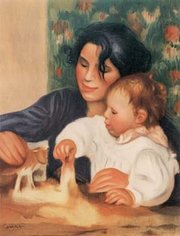Jean Renoir
|
|
JeanRenoir.jpg
Jean Renoir (September 15, 1894 – February 12, 1979), born in the Montmartre Quarter of Paris, France was a film director.
Renoir was the second son of Aline Victorine Charigot and one of the world's most famous painters, Pierre-Auguste Renoir.
Life and work
When he was a child, his family moved to the south of France. He and the rest of the Renoir family would be the subject of many of his father's paintings. As a young man, his father's financial success ensured that Jean was educated at the best of schools. However, his education was interrupted when World War I broke out and he joined the army, serving first as a cavalryman and later as a pilot. He was injured in action, which left him with a permanent limp. After the War, Jean Renoir worked as a ceramic artist but soon became fascinated by the developments in motion pictures, particularly by the works of D. W. Griffith and Charles Chaplin, who he knew for several years only by his French name, Charlot.
In 1925, he directed the first of several silent films, many of which starred his first wife, Catherine Hessling. Associated with the Popular Front in the mid thirties, several films such as Le Crime de Monsieur Lange reflected the movement's politics. In 1937 he directed what many see as his first masterpiece, "La Grande Illusion." The film was banned as French propaganda in Germany by senior Nazi leader, Joseph Goebbels, and eventually by Mussolini in Italy after it won the "Best Artistic Ensemble" award at the Venice Film Festival. This was followed by another cinematic success: "La Bête Humaine (The Human Beast)," a film based on an Emile Zola novel and starring the immensely popular Jean Gabin.
In 1939, Renoir directed "La Règle du Jeu (The Rules of the Game)", a film about upper-class French society just before the start of World War II. Renoir also appears in the film as one of the main characters. The film was initially judged to be too gloomy and was greeted with derision by a Parisian crowd on its premiere. The French government duly banned it, but in later decades it came to be recognized as one of the greatest films of all-time.
When World War II came, the 45-year-old Renoir joined the Film Service of the French army. With the German invasion and Occupation in 1941, he fled France to the safety of the United States where he worked in the film industry in Hollywood, California. In 1943, he produced and directed an anti-Nazi propaganda film: "This Land Is Mine," starring Maureen O'Hara and Charles Laughton. Two years later he made "The Southerner," a film regarded as his best work in America and one for which he was nominated for an Academy Award for Directing. In 1946, Renoir became a naturalized citizen of the United States.
In 1962, Jean Renoir wrote a biography titled: Renoir, My Father. In 1975 he received an Academy Award for his lifetime contribution to the motion picture industry and that same year a retrospective of his work was shown at the National Film Theatre in London. In 1977, the government of France awarded him with the Legion of Honor. His life story titled My Life and My Films was published in 1974. In it, he talks about the profound influence of Gabrielle Renard, the woman seen here in the portrait by his father. Renard was a cousin of his mother and the family nanny who helped raised Jean from birth and who introduced him to the world of the cinema.
Jean Renoir died in Beverly Hills, California on February 12, 1979. His body was returned to France to be interred beside his family in the Essoyes Cemetery, in Essoyes, Aube, France.
Jean Renoir has a star on the Hollywood Walk of Fame at 6212 Hollywood Blvd.
Filmography
Some of his significant films are:
- La Chienne (The Bitch) (1931)
- Boudu Sauvé des Eaux (Boudou Saved from Drowning) (1932)
- Le Crime de Monsieur Lange (1936)
- La Grande Illusion (1937)
- La Bête Humaine (The Human Beast) (1938)
- La Règle de Jeu (Rules of the Game) (1939)
- This Land Is Mine (1943)
- The Southerner (1945)
- French Can Can (1955)
External link
- Grand Illusion & The River (http://www.filmref.com/directors/dirpages/renoir.html)
- Template:Imdb nameda:Jean Renoir
de:Jean Renoir es:Jean Renoir fr:Jean Renoir it:Jean Renoir ja:ジャン・ルノワール nl:Jean Renoir pt:Jean Renoir sk:Jean Renoir sv:Jean Renoir

